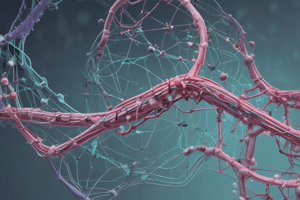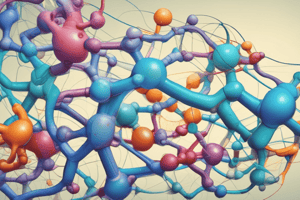Podcast
Questions and Answers
What stabilizes protein structures?
What stabilizes protein structures?
- Hydrophobic effect only
- Ionic interactions only
- Covalent interactions only
- Noncovalent interactions and forces (correct)
What determines the tertiary structure of a protein?
What determines the tertiary structure of a protein?
- Quaternary structure
- Amino acid sequence (correct)
- Secondary structure
- Peptide bonds
What impacts the formation of regular secondary structures in proteins?
What impacts the formation of regular secondary structures in proteins?
- Tertiary structure
- Amino acid composition (correct)
- Peptide bonds
- Quaternary structure
What describes the interactions between components of a multisubunit assembly?
What describes the interactions between components of a multisubunit assembly?
What plays an important role in the initial folding of polypeptides?
What plays an important role in the initial folding of polypeptides?
Which protein is required for the folding of proteins that do not fold spontaneously?
Which protein is required for the folding of proteins that do not fold spontaneously?
What is the molecular basis for many human genetic disorders related to protein folding?
What is the molecular basis for many human genetic disorders related to protein folding?
What protein is associated with extracellular amyloid deposition in Alzheimer's disease?
What protein is associated with extracellular amyloid deposition in Alzheimer's disease?
Which protein is involved in the intracellular aggregation in Huntington disease?
Which protein is involved in the intracellular aggregation in Huntington disease?
What is the protein associated with misfolded brain protein in prion diseases?
What is the protein associated with misfolded brain protein in prion diseases?
What is the study of three-dimensional structures of biomolecules, including proteins, nucleic acids, lipid membranes, and oligosaccharides?
What is the study of three-dimensional structures of biomolecules, including proteins, nucleic acids, lipid membranes, and oligosaccharides?
What catalyzes the interchange, or shuffling, of disulfide bonds in proteins?
What catalyzes the interchange, or shuffling, of disulfide bonds in proteins?
What do structural biologists use various methods to solve?
What do structural biologists use various methods to solve?
What largely stabilizes a protein's conformation?
What largely stabilizes a protein's conformation?
What contributes hydrogen bonds and ion pairs to protein folding?
What contributes hydrogen bonds and ion pairs to protein folding?
What limits the range of conformations a protein can assume?
What limits the range of conformations a protein can assume?
What favors protein folding by decreasing solvation layer entropy?
What favors protein folding by decreasing solvation layer entropy?
What is a common protein secondary structure, with every backbone N−H group hydrogen bonding to the backbone C=O group of the amino acid that is four residues earlier in the protein sequence?
What is a common protein secondary structure, with every backbone N−H group hydrogen bonding to the backbone C=O group of the amino acid that is four residues earlier in the protein sequence?
What promotes protein folding by combining weak interactions?
What promotes protein folding by combining weak interactions?
What involves pathways regulating protein folding, unfolding, and degradation?
What involves pathways regulating protein folding, unfolding, and degradation?
What causes many human diseases?
What causes many human diseases?
What do native proteins exist in?
What do native proteins exist in?
What is included in protein secondary structure?
What is included in protein secondary structure?
What do proteins assume without breaking covalent bonds?
What do proteins assume without breaking covalent bonds?
What confers significant stability to the helical backbone?
What confers significant stability to the helical backbone?
Why do Proline and Glycine occur infrequently in an α helix?
Why do Proline and Glycine occur infrequently in an α helix?
What does circular dichroism spectroscopy differentiate between in proteins?
What does circular dichroism spectroscopy differentiate between in proteins?
What does the tertiary structure of a protein refer to?
What does the tertiary structure of a protein refer to?
What type of proteins give strength and flexibility to structures?
What type of proteins give strength and flexibility to structures?
What influences the stability of the α helix?
What influences the stability of the α helix?
What organizes polypeptide chains into sheets in the β conformation?
What organizes polypeptide chains into sheets in the β conformation?
Which type of β sheets are more frequently found in natural proteins?
Which type of β sheets are more frequently found in natural proteins?
What does the quaternary structure of a protein involve?
What does the quaternary structure of a protein involve?
How can common secondary structures in proteins be visualized and assessed?
How can common secondary structures in proteins be visualized and assessed?
What do globular proteins have a more compact and diverse tertiary structure adapted for?
What do globular proteins have a more compact and diverse tertiary structure adapted for?
What influences the stability of the α helix near the end of the segment?
What influences the stability of the α helix near the end of the segment?
What does the PDB ID represent?
What does the PDB ID represent?
What do folding patterns of proteins involve?
What do folding patterns of proteins involve?
What is the basis for protein structural classification in the PDB and SCOP2 database?
What is the basis for protein structural classification in the PDB and SCOP2 database?
What represents the relationships among segments of secondary structure in a protein?
What represents the relationships among segments of secondary structure in a protein?
What do protein families and superfamilies involve?
What do protein families and superfamilies involve?
What does denaturation cause?
What does denaturation cause?
What is the process by which denatured globular proteins regain their native structure and biological activity?
What is the process by which denatured globular proteins regain their native structure and biological activity?
What facilitates functional promiscuity and interaction with multiple binding partners?
What facilitates functional promiscuity and interaction with multiple binding partners?
What is the continual maintenance of the active set of cellular proteins required under given conditions known as?
What is the continual maintenance of the active set of cellular proteins required under given conditions known as?
What range do quaternary structures involve?
What range do quaternary structures involve?
What do amino acid sequence determine?
What do amino acid sequence determine?
What are complex motifs built from?
What are complex motifs built from?
Flashcards are hidden until you start studying
Study Notes
Protein Structure and Folding: Key Concepts
- PDB ID is assigned to experimentally determined 3D structures with data files containing atomic coordinates, structure determination, and accuracy information
- Folding patterns of proteins involve motifs, recognizable folding patterns, and domains, independently stable parts of a polypeptide chain
- Protein-folding rules such as burial of hydrophobic R groups, α helices, and β sheets in different layers, and stable folding patterns
- Complex motifs are built from simple motifs, and some proteins or segments are intrinsically disordered lacking definable structure
- Intrinsically disordered segments can assume different structures, facilitating functional promiscuity and interaction with multiple binding partners
- Protein motifs form the basis for protein structural classification in the PDB and SCOP2 database, with a limited number of folding patterns
- Topology diagrams represent the relationships among segments of secondary structure in a protein
- Protein families and superfamilies involve proteins with significant similarity in primary and tertiary structure, with strong evolutionary relationships
- Quaternary structures range from simple dimers to large complexes, involving the assembly of multiple peptide subunits
- Proteostasis involves the continual maintenance of the active set of cellular proteins required under given conditions, with protein denaturation and folding pathways involved
- Denaturation causes loss of three-dimensional structure and function, occurring through heat, pH extremes, and other factors, leading to protein precipitation
- Amino acid sequence determines tertiary structure, and renaturation is the process by which denatured globular proteins regain their native structure and biological activity
Studying That Suits You
Use AI to generate personalized quizzes and flashcards to suit your learning preferences.




